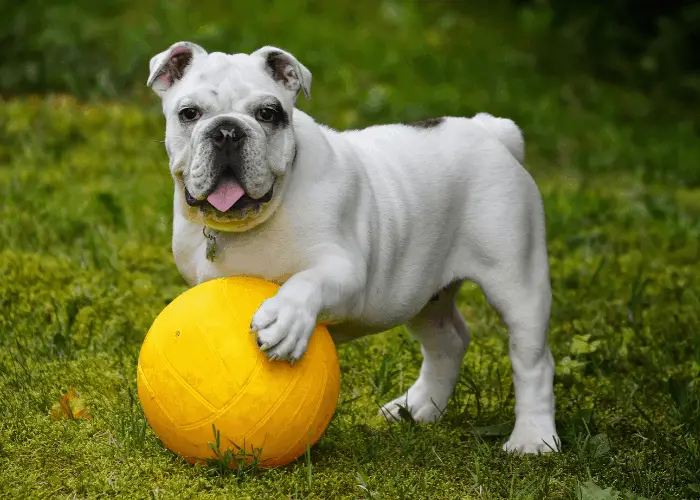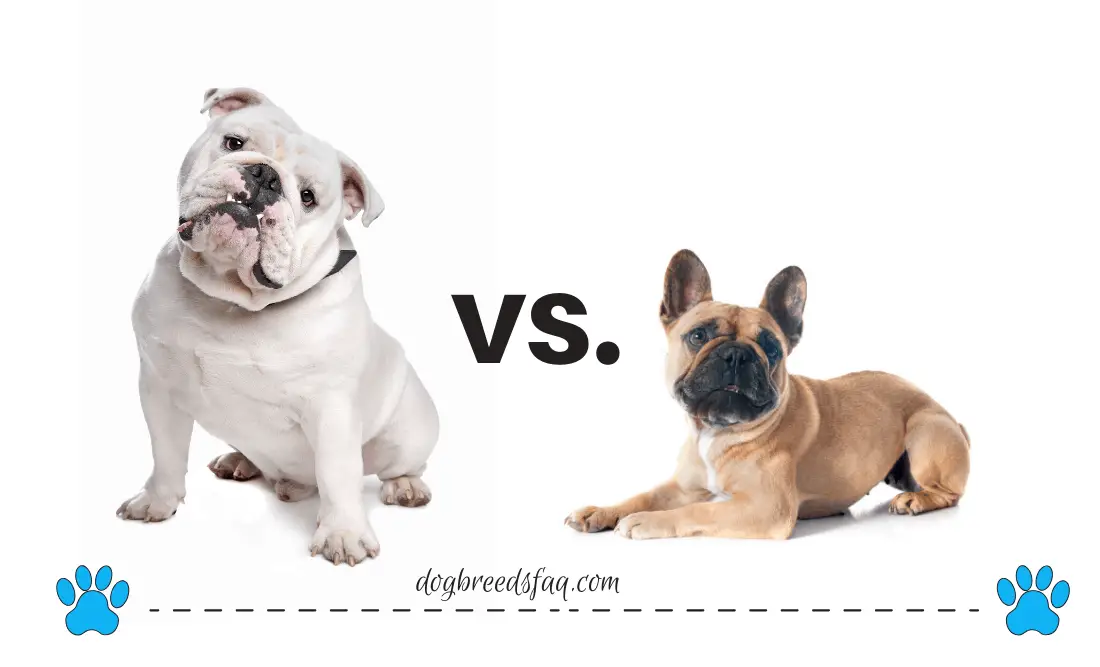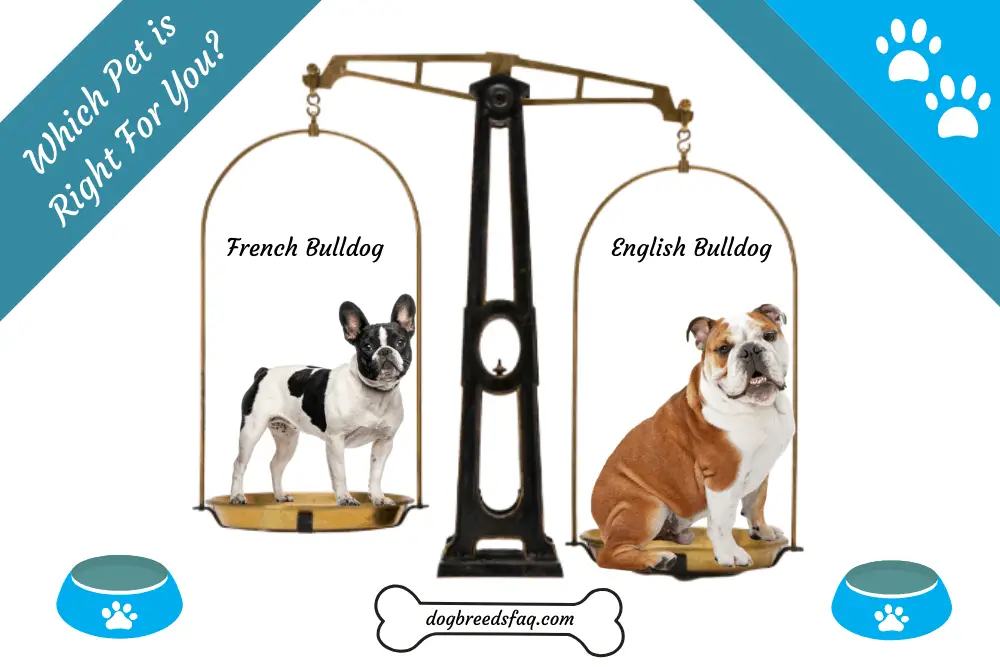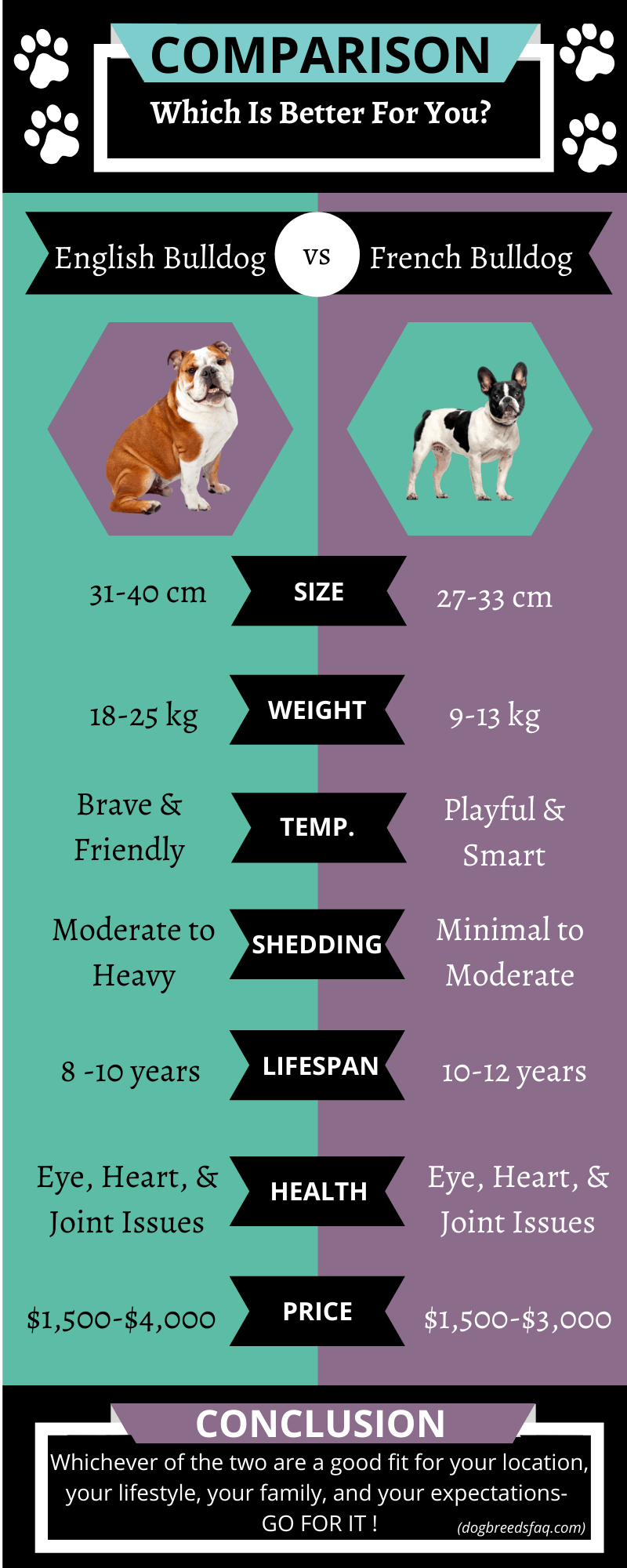Though they share a similar name, there are few similarities between these two popular breeds of K9.
We’re going to compare English Bulldog vs French Bulldog, to help contrast the differences between the two breeds so that potential owners can choose more wisely when in the market for a new best friend.
That said, there are several different bulldog types, some are similar to others, but all are different enough to look different, behave differently, different shapes and sizes, etc…
Make sure that you have the right Bulldog type in mind before making any purchase decisions, as they all have different levels of care.
But for our purposes here today, out of the many varieties of the breed, we’re going to examine the strengths and weaknesses of the English Bulldog and the French Bulldog.
The French Bulldog

The French Bulldog is the smallest of the Bulldog family, having been bread to be a toy version of the breed.
With most of them maintaining a weight under 28 pounds, and not growing much larger than 12-13 inches at the shoulder, the French Bulldog is your choice if it’s a lap dog you’re looking for.
This would be the choice for apartments or houses with smaller yards. They do maintain the appearance of a small Bulldog, with the exception of the tall standing ears that are a stark difference between them and the other breeds that have smaller, folding type ears.
They’ve got the wide-body, well-planted stance, muscular frame, and the loose skin around the face, head, and shoulders, that Bulldogs are known for.
They have been known to be easy to train, obedient to French dog commands or other languages most of the time, but like all other Bulldog types, they are known to be stubborn at times.
What is the Origin of the French Bulldog?

The French Bulldog (Frenchie) Was originally bred from the Old English Bulldog, though it bears more of the appearances of the English. (Credits to Wikimedia Commons for this image.)
As stated above, the breeder’s intentions were to create a toy version of its much larger, heavier, and more aggressive ancestry.
But rather than having the fortitude to attempt to take down a bull, these were used for ratting at most, and family house pets at best.
Being popular among lace workers, many of these dogs traveled with the lace working trade from England to France, where the dog grew in popularity and prominence.
Americans also took to the breed, resulting in the “French Bulldog Club of America,” which was the first of its kind for the breed; setting standards for the dog, giving it more legitimacy as its own breed.
The English Bulldog

This is the Bulldog that is most recognizable or is the image that strikes one’s mind when mentioning a Bulldog.
Stubby legs, large spherical head, a great big smile with equally big jowls, wrinkles, and an underbite that often puts their lower K9’s on display.
They are lower on the energy scale, require less activity than other dogs of its size, maybe around an hour a day.
They’re predictable, friendly, and never seem to lose that “puppy dog” appearance, even when fully grown to around 50-60 pounds and around 17” tall.
They are muscular, wide-bodied dogs that give you the sense that they’re always standing at attention.
These dignified dogs are used as mascots for all kinds of sports teams, Mack Truck hood ornaments, and can be seen in YouTube videos surfing or skateboarding.
What is the Origin of the English Bulldog?

The English (or British) Bulldog is one result of the attempt of breeders to repurpose Olde English Bulldogs after the gruesome sport of “Bullbaiting” became illegal in 1835.
This caused many changes and offshoots from the original breed, though there are still plenty of Olde English Bulldogs out there today.
Not nearly as athletic, tall, aggressive, or energetic as their forefathers, today’s English Bulldogs have set aside any evidence of having a worker/fighter background, and have been bred to be loveable “so ugly they’re cute,” calm dogs.
English Bulldog vs French Bulldog

Which would be right for you?
The following will be a series of dog questions and answers to help assist you with this decision.
1. Do you need a Big Yard?
For either of these breeds, no.
Both don’t require too much exercise.
However, for either breed, a fenced backyard would be an excellent luxury for either dog, but more so the English Bulldog, as for the most part, French Bulldogs are perfectly comfortable being indoor dogs.
2. Which is easier to care for, a French Bulldog, or an English Bulldog?
All dogs require different levels of care, but between the two, the English Bulldog would require more care, or better yet, maintenance.
Many of the physical traits that have been bred into the dog that people love are some of the very same traits that cause the dog problems if not cared for properly.
A solid bathing schedule is one area that is more important for the English Bulldog. Also taking care of their wrinkles is important, to prevent infections forming from irritation deep inside the wrinkles.
Also, English Bulldogs have a tendency to drool a lot more due to those adorable oversized jowls, so that is something that you’ll need to keep up with on a cleanliness level, but also wiping the dog’s mouth often will help to prevent over moisturization, that could lead to sores or infection.
3. Which between the two would be a better guard dog?
Generally speaking, the French Bulldog would make the better guard dog as it is more alert and higher strung enough to respond to what it feels is an intruder or something suspicious going on. But aside from making a lot of noise, that’s about it.
The English have a more relaxed temperament generally speaking, but case by case, you’ll find that sometimes the English do have the capacity to be better guard dogs than the French, as they can provide a more fearsome appearance along with some growling and barking. But these tend to be an exception rather than the rule.
4. Are French Bulldogs Healthier than English Bulldogs?
Both breeds can live healthy lives anywhere between 12-14 years old on average. However, just like many dogs that have been bred to have distinct features, they both have their share of potential problems.
That said, on average, the French Bulldogs tend to be the healthiest of all the different Bulldog types, having fewer things to worry about in the future.
Hip-dysplasia is the #1 problem suffered by English Bulldogs, and Von Willebrand’s disease is most the common problem for the French. This is where getting to know a breeder is very important.
Bulldogs suffer a host of different respiratory issues due to the over-breeding of their flat/pushed in face.
Because this is such a desirable and typical look for the breed, it has become an issue that is inherent.
It goes without saying that poor breeding foresight can be somewhat recognized when dealing with less reputable breeders, and the likelihood of winding up with a dog that will have issues is increased the lesser reputable the breeder.
The different ailments that have beset the English Bulldog breed are what began the mingling of other species into the fold to create other sub-breeds- such as the Victorian and Australian Bulldogs.
These have taken a few steps back on the wrinkles, made a tad less squashed face to be accepted, and stretched the legs just a little to make things easier on the hips.
5. How much Exercise does a French Bulldog Need?
Taking your French Bulldog out on a daily walk will help control your dog’s weight. However, they don’t require long walks to stay fit and trim.
Several short walks a day is what would be recommended, for potty purposes as well as exercise.
Indoor playtime is also a good addition to the dog’s exercise routine and will help to burn off a little energy too.
6. How much Exercise does an English Bulldog Need?
English Bulldogs aren’t very active by nature and run the risk of obesity if they haven’t gone out and taken in enough daily exercise.
Recommended: Can Bulldogs swim?
Like the French Bulldog, several short walks a day will be good to help keep potty habits outdoors, as well as giving the dog enough daily exercise to keep those muscles rippling.
Indoor or outdoor play is a good idea, and if your English Bully is in the mood, tug of war or fetch is often a favorite of theirs- albeit in short bursts until it’s time to lay back down.
Heat and Bulldogs don’t mix, and this should be taken seriously when it comes to giving them exercise- despite which breed you’ve chosen.
English Bulldog vs French Bulldog Comparison Infographic
Share this Image On Your Site By Copy Pasting The Code Below
<a href=”https://dogbreedsfaq.com/wp-content/uploads/English-Bulldog-vs-French-Bulldog-Comparison-Infographic-1.png”><img style=”width:100%;” src=”https://dogbreedsfaq.com/wp-content/uploads/English-Bulldog-vs-French-Bulldog-Comparison-Infographic-1.png”></a>Infographic via: <a href=”https://dogbreedsfaq.com/”>dog breeds FAQ</a>
Conclusion:
So, Which Type of Bulldog is for you?
After going over these different breeds, hopefully, you’ll be able to make a more educated decision.
You have the awesomeness of an English Bulldog with all of the care and work on one side, or the smaller, friskier French Bulldog with all of its positives as well on the other side.
With every breed of dog, there will be strengths and weaknesses, pros and cons. Whichever of the two are a good fit for your location, your lifestyle, your family, and your expectations- go for it!
No matter how you slice it, or what breed of Bulldog you lean toward. There isn’t quite anything like the sloppy and at times goofy regality of a Bulldog.



